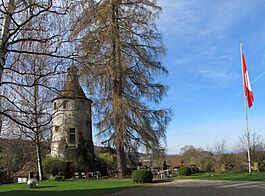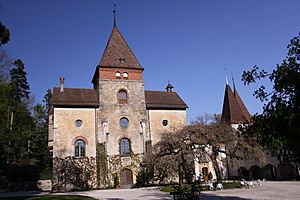Münchenwiler facts for kids
Quick facts for kids
Münchenwiler
|
||
|---|---|---|
 |
||
|
||
| Country | Switzerland | |
| Canton | Bern | |
| District | Bern-Mittelland | |
| Area | ||
| • Total | 2.48 km2 (0.96 sq mi) | |
| Elevation | 508 m (1,667 ft) | |
| Population
(Dec 2020 )
|
||
| • Total | 518 | |
| • Density | 208.9/km2 (541.0/sq mi) | |
| Postal code |
1797
|
|
| Surrounded by | Courgevaux (FR), Courlevon (FR), Cressier (FR), Murten/Morat (FR), Salvenach (FR) | |
Münchenwiler (which is called Villars-Les-Moines in French) is a small town in Switzerland. It is located in the Bern-Mittelland area of the canton of Bern.
Contents
History of Münchenwiler
Münchenwiler was first mentioned in old records around 1080-81. Back then, it was known as Vilar. Later, in 1228, it was called Vilar les Moinos.
Early Days and the Priory
Around 1080-81, two brothers, Gerold and Rudolf de Vilar, gave the village to Cluny Abbey. This was a famous monastery. Soon after, a priory was built. A priory is like a small monastery. It was a resting place for pilgrims traveling on the Way of St. James.
The priory church was built around 1100. It used old stones from Roman ruins in a nearby town called Avenches. The priory usually had a prior (the leader) and a few monks.
Challenges and Changes for the Priory
The priory faced tough times during wars in the 1300s and 1400s. It was damaged in the Battle of Laupen in 1339. It was also hurt during the Freiburgkrieg in 1448 and the Burgundian Wars in 1476.
By the 1400s, the priory became less important. In 1484, the Pope decided that the Munster of Bern would take over its leadership. Then, in 1528, Bern adopted the Protestant Reformation. This meant they changed their religion. Bern took control of Münchenwiler in 1530, even though Fribourg resisted.
Village Life and the Castle
A village grew up around the priory. Farmers worked the church's fields. The priory also built a tavern and a mill. These were run as a fief, which means they were managed by someone who paid rent or service to the prior. By 1436, the village had a shared bakery and a school.
At first, villagers went to church in the priory chapel. But after Bern took over, they joined the church in Morat. Even after Bern became Protestant, Münchenwiler stayed part of the Murten church area.
In 1535, Bern sold the Herrschaft (a type of territory) of Münchenwiler. It was bought by Hans Jakob von Wattenwyl. He was a former leader in Bern. Over the next two years, parts of the priory church and buildings were turned into a castle.
The castle stayed with the von Wattenwyl family until 1612. It then had several owners before the von Graffenried family bought it in 1668. They owned it until 1932. The castle was made bigger in 1690 and again in the 1800s. A new chapel was added in 1886.
In the early 1900s, the von Graffenried family became less wealthy. They started selling their land in 1922. In 1932, they sold the castle and its park. The Canton of Bern bought it in 1943. They turned it into a community school. Later, it became an adult education center. From 1986 to 1990, it was renovated and became a hotel and convention center.
Language and Location Changes
Münchenwiler was originally a French-speaking village. But after Bern took control, it became German-speaking. The village school started teaching in German in 1738.
After the French invaded Switzerland in 1798, Münchenwiler became part of a new canton called Sarine et Broye. The castle's lands were given to the town. When the new republic ended in 1803, Münchenwiler was put into the French-speaking Canton of Fribourg. But four years later, Bern managed to get the town back under its control.
In 1898, a railway station was built at Münchenwiler-Courgevaux. This connected the town to the Swiss train network.
Geography of Münchenwiler
Münchenwiler covers an area of about 2.5 square kilometers (about 1 square mile). A large part of this land, about 65.2%, is used for farming. Forests cover about 20.8% of the area. Buildings and roads take up about 11.6%. A small amount of land is rivers or lakes (0.8%) or unproductive (0.4%).
Münchenwiler is located on the southern shore of Lake Morat. It is a special part of Bern that is surrounded by the canton of Fribourg. This is called an exclave. The town is on the railway line that goes from Fribourg to Morat. The N1 motorway also passes through it in a tunnel.
At the end of 2009, Münchenwiler's old district was closed. On January 1, 2010, it joined the new Bern-Mittelland administrative district.
Coat of Arms
The blazon (description) of Münchenwiler's coat of arms shows a monk holding a green linden tree on a silver background. The word "monk" (Mönch in German) is similar to "München," which is part of the town's name. This makes it a "canting arm," meaning the picture hints at the name.
Population and People
Münchenwiler has a population of about 470 people (as of December 2011). About 11% of the people living here are from other countries. Over the past ten years, the population has changed a little.
Most people in Münchenwiler speak German. About 91.7% speak German as their main language. French is the second most common language (4.8%), followed by Italian (0.7%).
In 2008, about 51.3% of the population were men and 48.7% were women. Many people were born in Münchenwiler or in the same canton. About 6.2% of the people were born outside Switzerland.
Young people (0–19 years old) make up about 19.1% of the population. Adults (20–64 years old) are 66.4%, and seniors (over 64 years old) are 14.5%.
The chart below shows how the population of Münchenwiler has changed over time:

Important Heritage Sites
The Castle and its park are very important. They are listed as a Swiss heritage site of national significance. This means they are protected because of their historical and cultural value. The whole village of Münchenwiler is also part of the Inventory of Swiss Heritage Sites.
Economy and Jobs
In 2011, Münchenwiler had a low unemployment rate of 1.3%. This means most people who wanted to work had jobs. In 2008, there were 160 people working in the town.
Jobs are divided into three main types:
- Primary sector: This includes jobs like farming. About 30 people worked in this area.
- Secondary sector: This includes jobs in manufacturing and construction. About 74 people worked here.
- Tertiary sector: This includes jobs in services, like hotels, restaurants, and sales. About 56 people worked in this sector.
Many people who live in Münchenwiler also work there. In 2000, about 51.6% of the workers lived and worked in the town. Others traveled to nearby towns for work. About 10.9% used public transportation, and 61.1% used a private car to get to work.
Religion in Münchenwiler
According to the 2000 census, most people in Münchenwiler belonged to the Swiss Reformed Church (62.7%). About 15.9% were Roman Catholic. A smaller number of people belonged to other Christian churches, or were Muslims, Buddhists, or Hindus. Some people did not belong to any church.
Education in Münchenwiler
In Münchenwiler, about 51.5% of adults have finished upper secondary education. This is like high school. About 21.7% have gone on to higher education, like university.
The Canton of Bern has a school system that starts with one year of non-required Kindergarten. Then there are six years of Primary school. After that, students go to three years of lower Secondary school. Here, students are grouped by their abilities. After lower Secondary, students can continue their education or start an apprenticeship (learning a trade).
During the 2011–12 school year, 31 students attended classes in Münchenwiler. There were no kindergarten classes. The town had two primary classes with 31 students. Some of these students were not Swiss citizens, and some spoke a different language at home.
Transportation Options
Münchenwiler has a railway station called Münchenwiler-Courgevaux. It is on the Fribourg–Ins line. You can take trains from here to Fribourg/Freiburg, Ins, and Neuchâtel.
See also
 In Spanish: Münchenwiler para niños
In Spanish: Münchenwiler para niños






